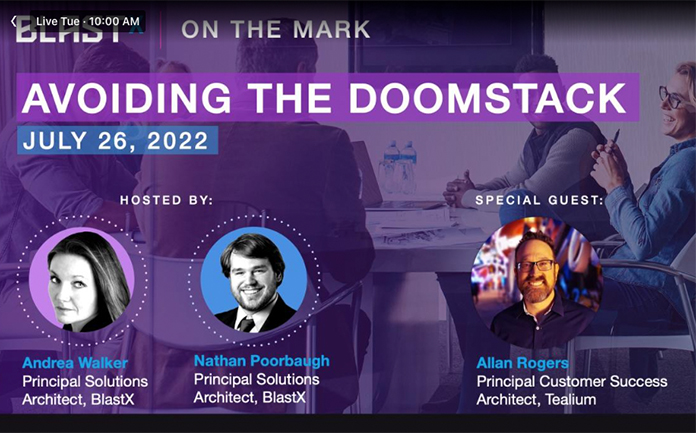Marketing technology – or MarTech – has evolved in leaps and bounds in recent years. Whatever the marketing goal or task you want to complete, you’re almost guaranteed to find software to help you complete that task.
We all want to successfully invest in and build a strong marketing technology stack. However, there are a lot of cases in which good intentions can lead marketers astray. Based on our years of hands-on experience implementing these solutions, we’ve compiled some pitfalls to avoid so that you don’t inadvertently create an organizational “doomstack.”
Many thanks to my colleague, Nathan Poorbaugh, for contributing his thoughts to this article.
Mistake #1: Focusing on MarTech Features, Not Outcomes

More times than I’d like to count, I’ve seen companies make vendors battle it out over feature authority. While it’s important that your technology has the key features needed for your team to do their job, don’t forget to think about the bigger picture. Do you have the resources to maintain these solutions? Does your team have the skills to execute? Does this solution integrate seamlessly with your other marketing technologies? And let’s not forget the biggest question of all: How can this solution improve business outcomes?
Mistake #2: Moving Ahead Without a Marketing Strategy

While tools can help you carry out many marketing-related tasks, they don’t replace the foundation of a solid marketing strategy. I’ve personally seen teams choose technology over strategy, and this typically doesn’t end well. Some key questions you need to know first and consider carefully:
- Who are your customers?
- What does the customer/prospect journey look like?
- What are your marketing goals?
- What marketing channels do you currently utilize?
Once you’ve solidified a marketing strategy, you’ll be able to identify where you can make improvements and choose technology solutions that can assist you in executing your strategy.
Mistake #3: Over-Planning, Under-Executing

While it’s vital to have a plan for both where you want to go and the path you’ll take to get there, it can be very easy to develop decision paralysis when working with tech vendors. This is understandable, as the investment can be significant in terms of both dollars and effort. However, if you’ve done the work of defining these goals up front, the decision itself should be relatively straightforward.
A few rules to remember:
- Don’t overcomplicate it.
- Nickel-and-diming can lead to crippling delays in execution.
- Always try to avoid adding contenders late into the process.
- The perfect is the enemy of the great.
I’ve seen numerous clients set themselves up very poorly for a tech stack rebuild or addition – simply because, at the moment they should be closing, they go back to the fact-finding stage.
Mistake #4: Building Your MarTech Stack on an Unsteady Foundation

When building a MarTech stack, you must plan for how every piece will fit together. Poor connections or feature changes can derail your future plans. I’ve often seen tech stacks derailed by features that tech companies have decided to sunset, change, or gate behind additional products. This can be mitigated in the contract stage: If there is any doubt at all, outlining the vital pieces to be maintained is one of the smartest moves you can make.
Sadly, it can be difficult to know the risks without extensive experience in this space. That’s where consultants come in: We have seen and tested far more technologies, and have witnessed a wider variety of situations, than most FTEs. If your MarTech stack has you scratching your head, drop us a line – we’re here to help.
G2 can also be a very solid resource for vetting customer satisfaction.
Join Us for “On the Mark: Avoiding the Doomstack”
Join us on Tuesday, July 26 at noon CT for our newest “On the Mark” episode, “Avoiding the DOOMstack”. Listen in on a lively discussion with MarTech leader and BlastX partner Tealium as we explore how to avoid pitfalls and get the most out of your MarTech stack.


